|
|
|
Sort Order |
|
|
|
Items / Page
|
|
|
|
|
|
|
| Srl | Item |
| 1 |
ID:
177710
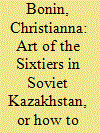

|
|
|
|
|
| Summary/Abstract |
The artists of the Sixtiers generation in Soviet Kazakhstan have typically been understood as the creators of an authentic Kazakh style. This article demonstrates that a web of constructed vectors helped consolidate art as ‘Kazakh’ in the 1960s and early 1970s. I argue that the Sixtiers mined the history of nomadic populations in Central Asia for site-specific cultural forms as a means to connect with an expanding art world and the global context of decolonialization. Neither wholly official nor countercultural, the Sixtiers produced a cultural milieu that stretched the limits of the sayable in late Soviet socialism and defined the margins of modernity with which Kazakh artists continue to contend.
|
|
|
|
|
|
|
|
|
|
|
|
|
|
|
|
| 2 |
ID:
177713
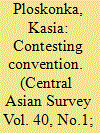

|
|
|
|
|
| Summary/Abstract |
This article examines artistic intervention into local conventions as a means of eliciting social awareness within the current cultural space of Dushanbe, Tajikistan, in which self-censorship is commonplace. As is to be expected, the art receiving the greatest support is sponsored by the authoritarian regime, who use it as a soft tool to construct a desired or prescribed form of national identity and to project state symbols into the global arena. In contrast, artworks which are contentious in their subject matter are mainly supported through international agencies. I explore the agency and autonomy of contemporary art, notwithstanding continuing state efforts at controlling, co-opting and incorporating art into a nationalist and legitimizing narrative. By focusing on selected artworks shown in Dushanbe within the last decade, where there are only a handful of artists work in this genre, I investigate how they unpack current societal issues of women’s rights, shifting ideologies, Islamization and civic duty.
|
|
|
|
|
|
|
|
|
|
|
|
|
|
|
|
| 3 |
ID:
177712
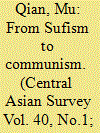

|
|
|
|
|
| Summary/Abstract |
‘Imam Hüsäynim’, a traditional song about the martyrdom of the Shi’a Imam Husayn ibn Ali, has been popular among the Uyghur Sufis in Khotan, an oasis town in Xinjiang, or Chinese Central Asia. People perform it in the dastan epic, mäshräp gathering, and localized samāʿ ritual. The categorization of these repertoires is based not only on musical styles but also on religious meanings, which makes ‘Imam Hüsäynim’ a song that can be used across repertoires. Although the song is about a Shi’a Imam, the Uyghur people, who are dominantly Sunni Muslims, do not associate it with Shi’a Islam but receive it as a song about the history of Islam in general. Outside the Sufi community, the song’s melody has been adapted as the theme song of a comedy film and a propaganda song to promote a county’s image. These incarnations of the song have lost the meaning of ‘Imam Hüsäynim’ because of radical changes of its text and context. Why has this particular melody been appropriated in these various ways, and what are the dynamics among its different versions and incarnations? Based on ethnographic research in Khotan and relevant ethnomusicological literature, this article will discuss the factors that determine the meanings of ‘Imam Hüsäynim’ and its incarnations, and the broader issue of repertoire crossover.
|
|
|
|
|
|
|
|
|
|
|
|
|
|
|
|
| 4 |
ID:
177708
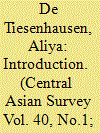

|
|
|
|
|
| Summary/Abstract |
Central Asian art and culture have been gaining increased attention both within the region and on the international scene. This special issue brings together scholars and participants in the Central Asian cultural scene who specialize in different, often isolated, spheres. This multidisciplinary approach will enhance understanding of the current trends of display, presentation, accessibility and analysis that relate to individual countries, as well as to the entire region. Some articles are by established scholars; most have resulted from extensive field research. The papers question existing notions of history and memory production by applying a decolonial discourse. Ultimately, the main unifying theme is that of identity and its formation, including national, ethnic, cultural, religious and gender. The main purpose of this special issue is to try to understand the role the cultural scene plays in society, the issues raised by cultural production and the shape it could take. The collection of papers here seeks to explore whether culture offers a representation of society and its potential for change, or the vehicle through which such change can be achieved.
|
|
|
|
|
|
|
|
|
|
|
|
|
|
|
|
| 5 |
ID:
177709
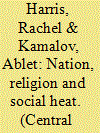

|
|
|
|
|
| Summary/Abstract |
This article brings together archival and ethnographic research to explore the ways that expressive culture and intangible cultural heritage flow across national borders, how transnational communities in Central Asia engage with discourses and practices of preservation and revitalization, and how local heritage initiatives can respond to the pressures of economic marginalization, migration, Islamization and cultural assimilation. Mäshräp gatherings involving music, dancing and joking have played a prominent role in modern imaginings of Uyghur national identity, and in local processes of community-making. Since 2009, Uyghurs in Kazakhstan have engaged in new forms of ‘heritaging’ mäshräp, attempting to revive their role as a medium for strengthening communities and sustaining language and culture. We argue that the unruly, affective and performative aspects of mäshräp are key to the success of these social goals, and we highlight their role as a space for the negotiation of tensions between religion, nation and hot sociality.
|
|
|
|
|
|
|
|
|
|
|
|
|
|
|
|
| 6 |
ID:
177714


|
|
|
|
|
| Summary/Abstract |
This article explores contemporary artistic practices in Kazakhstan that challenge narratives on national belonging and identity through the notion of queerness. It discusses artworks created by artists Saule Dyussenbina, Natalya Dyu and Kuanish Bazargaliyev, the artistic duo Kreolex Center, and the advertising agency Havas Worldwide Kazakhstan, which were created as a reaction to global discussions around gender and sexuality happening in and between various countries. It seeks to scrutinize different approaches and aspects presented in each artwork and argues that the overall strategy present in all the artistic testimonies is humour. While drawing on key concepts and categorizations of humour that permit the uncovering of the ways in which humour creates specific knowledge and identity, this article looks at humour techniques more broadly and builds on the argumentation provided by Uroš Čvoro and Chrisoula Lionis that opt for humour analysis connected to temporality and its perception in the works of art.
|
|
|
|
|
|
|
|
|
|
|
|
|
|
|
|
| 7 |
ID:
177711
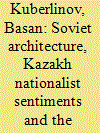

|
|
|
|
|
| Summary/Abstract |
Using the example of the construction of two major architectural projects – the short-lived national capital city of the Kazakh Autonomous Soviet Socialist Republic (Kazakh ASSR) Kyzylorda and the House of Government of the Kazakh ASSR in Almaty – the article investigates the development of Soviet architecture in Kazakhstan and links it to the political changes of the 1920–30s. It considers how the building process in Kazakhstan changed under the growing influence of the central Soviet authorities and became dependent on Moscow architectural organizations and construction companies. Furthermore, the article demonstrates the attempts to represent the Kazakh national character in traditionalist and Constructivist architecture associated with the nationalist sentiment of the national communists in the Soviet Kazakh government. It argues that the growing influence of the central Soviet authorities on construction in Kazakhstan furthered the adoption of Constructivist architecture as the main style of the new Soviet Kazakhstan.
|
|
|
|
|
|
|
|
|
|
|
|
|
|
|
|
|
|
|
|
|